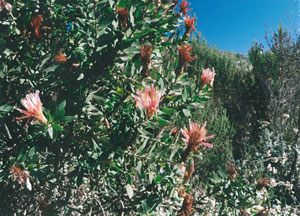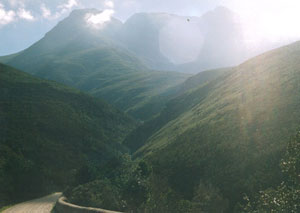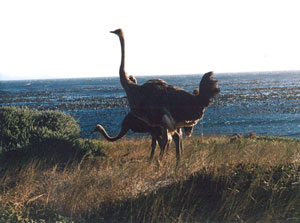Design Your Own Safari-Birds, Beasts & Botany:A Southern African
Sampler
by Henry Scammell

Elephants have the right of way in South Africa’s
many parks and game farms.
Looking for unusual destinations, with an itinerary tailored
to your personal interests? Here's one we found in far-away South
Africa, with one of the area's great safari guides.
Peter Ginn is a true man for all seasons: lecturer, naturalist,
world-class photographer, one-time diamond prospector for De Beers,
and more recently a safari guide and author/editor of
The Complete Book of Southern African Birds. His elegant,
sumptuous, door-stopper of a book is widely viewed as the most comprehensive,
scholarly volume of bird photographs ever assembled in this prolific
corner of the world. The region boasts an astonishing mix of birds
and animals, unusual plant life and interesting geological features,
and there is hardly a part of God's creation that lies outside Ginn's
intimate knowledge.
A South African by birth, for much of his adult life Peter lived
in Zimbabwe, dividing his time among teaching geography and science
at Peterhouse School in Marondera, writing about and photographing
birds, and leading safaris for ornithologists from around the world.
He pursued these latter interests as far afield as Victoria Falls
in the westernmost corner of the country, and well beyond its borders
into Botswana, Namibia, Swaziland, Madagascar and his old homeland
of South Africa. Two years ago, after the pendulum's swing away
from apartheid in the south was matched by a sudden rise of race-based
nationalism in the north, he and his wife Liz returned their native
land. They settled in the seaside town of George, just east of Cape
Agulhas, the continent's southernmost point. But other than the
new address, little has changed in the way he makes his living.
He continues to plan personalized tours for small groups wishing
to visit southern Africa. These trips can be arranged as self-drive
trips or a courier plus mini-bus or a professional guide. Ginn is
a registered guide in all nine of South Africa's provinces.

More varieties of Protea (250) grow in South
Africac than any other place on earth.
He and Liz settled in this area because it offers the unique
Cape Floral Kingdom, smallest of its kind but with an incredible
variety of endemic plant species of which the best known are probably
the colorful Ptoteas. This supports a number of unique endemic bird
species as well. A wide choice of habitats such as sub-tropical
rain forest, coastal zone, Fynbos, Succulent Karoo and Great Karoo
ensure a variety of bird and animals.
By design, most of his safari groups are small - typically 3
or 4 couples - and most members know each other before they get
together for the adventure. Friends are more likely to be compatible,
and this size group permits maximum economy on his guiding fee,
vehicle rental and gas costs. Ginn doesn't object to solo participants,
but single supplements tend to be expensive so whenever practical
he recommends that individuals share a room – as all places offer
some rooms with single beds.
Because southern Africa is so far from just about anywhere, travelers
should allow enough time to warrant the trip and to experience a
reasonable number of habitats and to get the most out of the regions
astonishingly rich and varied natural wonders. Most of Ginn's safaris
are at least 14 days, and can be designed for 16, 18 or longer.
He prefers that the group arrive together; if anyone wants to go
elsewhere they do this after the end of the tour. He is licensed
to guide in all South African provinces, so if the whole group would
like to go on to somewhere like Kruger or Victoria Falls, he can
organize and guide that as well.
The design of a tailored tour is based on several criteria. An
obvious motive for birders is to add to their life list of sightings.
Ginn is a living library of avian identities, including calls and
songs, and it's not unusual for first-timers to add 200 or more
new species on a single safari. And of course, in many national
parks and new safari farms there are the wild animals: rhino, elephant,
Cape buffalo, hippo, zebra, giraffe, lion, leopard, antelope, kudu,
baboon, monkey - the list seems endless. But whatever its primary
focus, to get the most out of the trip a group should have a wider
interest than just looking at birds or big game. "I like to organize
visits to scenic sites, villages and working farms as well as the
obvious parks and nature reserves," Ginn says. "It's a way of learning
about the area and meeting its people with far more intimacy than
is possible with larger groups or more rigid itineraries." He also
designs the trip to assure a variety of habitats and scenery.

Built by miners, Montegue Pass above George
connects the verdant coastlands with the arid plains to the north.
There is a similar range of choice in types of accommodation.
Some groups favor fully catered lodges, others B&Bs, hotels, or
self-catering chalets featured in most national parks and major
resorts. Meals planning is equally flexible, whether do-it-yourself
or in a restaurant. Here is a brief smorgasbord of activities and
places from which travelers are invited to select their dream vacation
with Ginn's guidance:
Groups usually start their tours at either George or Cape Town
- both served by South African Airways. George offers coastal and
mountain scenery; major habitats are the Fynbos and sub-tropical
Forest.
To the north, Little Karoo is known for its spectacular scenery
and abundant plant life – if the timing is right, he can arrange
a private visit to the isolated Kamanassie Reserve. Red Stone Hills
at the feet of the mighty Swartberg range are reminiscent of Sedona,
Arizona.
Further north is semi-arid Great Karoo, with its antelope such
as Springbok and the comparatively rare Mountain Zebra in the Karoo
National Park at Beaufort West. The area is noted for its wool-producing
merino sheep which thrive on the succulent shrubs.
Beyond that lie the white sand dunes of Witsand Nature Reserve
, known to "growl" in the proper wind.
Moving westward, we reach the Agulhas plain; its bottommost point,
Cape Agulhas, is where Africa ends and the Indian Ocean meets the
South Atlantic.

Wild ostriches at the Cape of Good Hope.
Further west are the strange rock formations of Cederberg and
West Coast National Park with a wealth of interesting birds. Namaqualand
usually flowers September to early November, depending on the winter
rains.
Stellenbosch, in the heart of South Africa's winelands, is a
favorite finale, not only because it is so hospitable and scenic
(we recommend the Rosenview B&B - colorful, idyllic, surprisingly
affordable), but also because this historic area offers a convenient
base for exploring the delights of Cape Town, Table Mountain, and
the dramatic Cape Peninsula.
Because each safari is tailored to the interests of participants,
and because group sizes and length of trip will vary, it is hard
to generalize about costs. However, here are some guidelines for
estimating the typical price per day per traveler, assuming a group
of 6:
- B&B $50 (+ $100 for a hotel, no meals. Game lodges
at least double this, with meals and game activities included.)
- Minivan and Gas: $30
- Licensed Guide (Peter Ginn): $40
Except for breakfasts at a B&B, the above prices don't include
meals. Food is reasonable in South Africa - probably below comparable
offerings in America - but of course the cost depends on where,
what, and how much you eat and drink. Accommodation costs can vary
as well.
The other big price item is transportation. A round-trip coach
ticket from New York is usually around $1,200, but bargains reward
the patient seeker. Iberia, for example, offers round trips JFK-Johannesburg
for as low as $500, with conditions and limits. South African Airways
and a couple of smaller carriers offer frequent, convenient and
low-cost connections from New York or Atlanta to Johannesburg or
Cape Town, with easy, frequent connections to George.
Interested? For more information, e-mail Perter Ginn at
pgbs@cyberperk.co.za.
You can also call or FAX him from the US at 011-27-44-874-6372 (just
remember the 7 hour time difference from the east coast - and 9
hours from Pacific time.) His mailing address is Peter Ginn Bird
Safaris, 1 Koer Avenue, George 6529. Republic of South Africa.
|